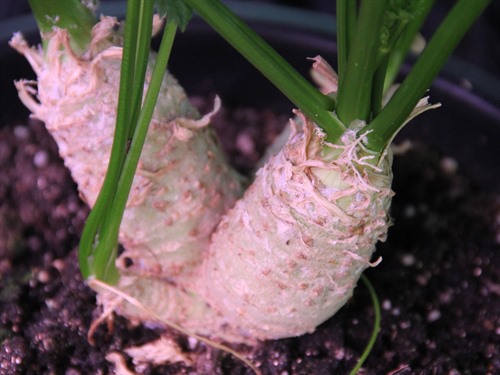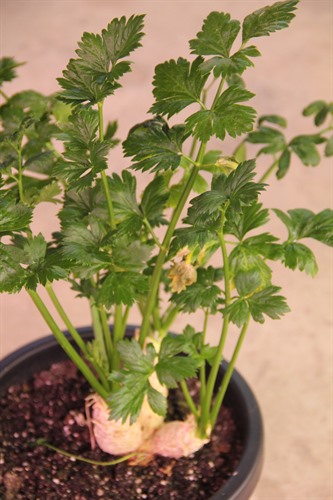
Back
Apium graveolens (Mill.) DC. L. var. rapaceum
| Family Name: | Apiaceae (Umbelliferae) |
| Common Name: | Celeriac, Turnip-rooted Celery, Knob Celery |
Name
Classifications and Characteristics
| Plant Division | Angiosperms (Flowering Seed Plants) (Dicotyledon) |
|---|---|
| Plant Growth Form | Herbaceous Plant |
| Lifespan (in Singapore) | Perennial, Biennial |
| Mode of Nutrition | Autotrophic |
| Maximum Height | 0.6 m to 0.9 m |
| Maximum Plant Spread / Crown Width | 0.3 m to 0.5 m |
Biogeography
| Native Distribution | Europe, Asia, Africa |
|---|
Description and Ethnobotany
| Growth Form | Biennial or perennial herb. |
|---|---|
| Roots | The turnip-like root is round to cylindrical. |
| Foliage | Pinnately compound, aromatic leaves are arranged in a basal rosette. |
| Flowers | The umbrella-shaped inflorescence (known as an umbel) is composed of off-white flowers. In biennial plants, the flowers are produced in the second year of the life cycle. |
| Cultivation | Celeriac is a cool-season crop which grows best at 16-24 degrees Celsius in a sunny location with rich, moist well-drained soil. The root is ready to be harvested at 3-4 months. It will be difficult to grow this variety outdoors in Singapore, because it does not like hot, humid climates. |
| Ethnobotanical Uses | Edible Plant Parts : Edible Leaves, Edible Storage Organs Food (Fruit or Vegetable): Celeriac is a root vegetable which tastes like celery, but has a texture similar to potatoes. It can be eaten raw or cooked, such as in a baked casserole, stir-fry or stew. |
Plant Care and Propagation
| Light Preference | Full Sun |
|---|---|
| Water Preference | Lots of Water, Moderate Water |
| Plant Growth Rate | Fast |
| Rootzone Tolerance | Moist Soils, Well-Drained Soils, Fertile Loamy Soils |
| Fertilizing | This plant must be fertilized regularly. |
| Potential Problems | Celeriac is prone to attack by aphids, nematodes and slugs. The root may be attacked by mealy bugs. |
| Diseases | It may develop root rot in wet soils. It is sometimes afflicted with early blight and late blight. |
| Pest(s) | Chewing Insects, Sucking Insects, Nematodes |
| Propagation Method | Seed, Storage Organ |
| Planting Distance | 20 cm to 25 cm |
Foliar
| Mature Foliage Colour(s) | Green |
|---|---|
| Mature Foliage Texture(s) | Raised / Sunken Veins |
| Prominent Young Flush Colour(s) | Green |
| Young Flush Texture(s) | Raised / Sunken Veins |
| Foliar Type | Compound |
| Foliar Arrangement Along Stem | Rosulate / Rosette |
| Foliar Attachment to Stem | Petiolate |
| Foliar Shape(s) | Non-Palm Foliage (Oblong) |
| Foliar Venation | Pinnate / Net |
| Foliar Margin | Serrate / Toothed |
| Foliar Apex - Tip | Acute |
| Foliar Base | Acute |
Floral (Angiosperm)
| Flower Colour(s) | Cream / Off-White |
|---|---|
| Flower Grouping | Cluster / Inflorescence |
| Flower Location | Terminal |
| Flower Symmetry | Radial |
| Inflorescence Type | Umbel |
Image Repository
Others
| Master ID | 33662 |
|---|---|
| Species ID | 8076 |
| Flora Disclaimer | The information in this website has been compiled from reliable sources, such as reference works on medicinal plants. It is not a substitute for medical advice or treatment and NParks does not purport to provide any medical advice. Readers should always consult his/her physician before using or consuming a plant for medicinal purposes. |



.jpg)